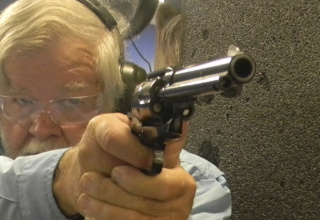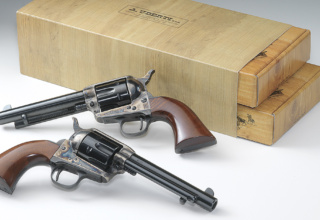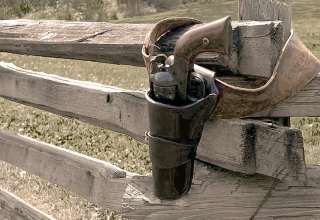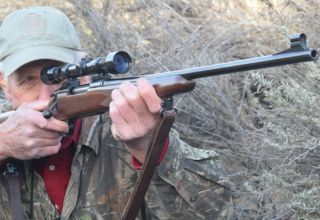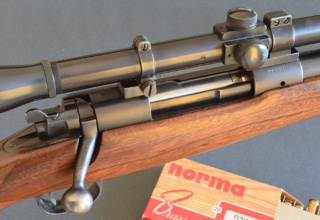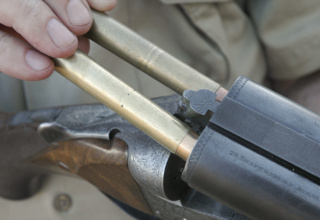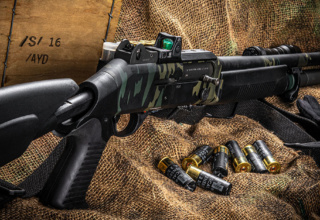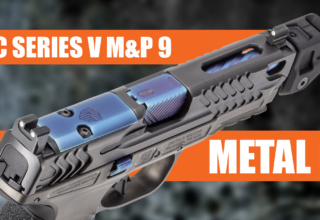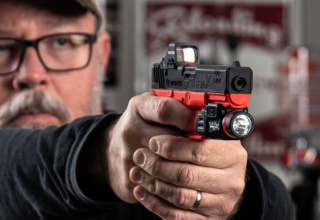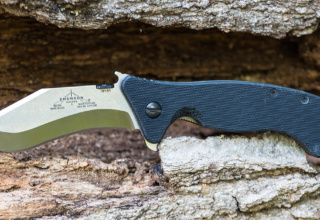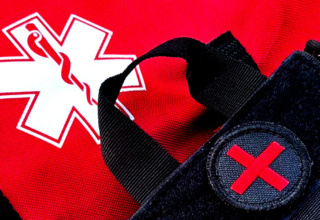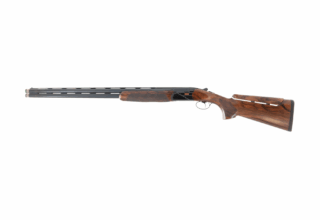Slap leather, Varmint! Fill your hand with authentic big-bore steel Sam Colt would have admired!
by Wayne van Zwoll
Found in an old house in New Hampshire, the Colt Peacemaker lacked any link to famous people or frontier violence. The owner’s widow sold it to a visitor for $4. That was in 1925. Six decades later, at a Christie’s auction, it fetched $242,000.
Such discoveries are now scarce as pterodactyls. Even single-action Colts post-dating 1896, when the vertical screw locking the cylinder pin gave way to a horizontal lock, bring five-figure prices, says the Blue Book of Gun Values. Dig deeper still for provenance and minimal holster wear. Most of the meteoric bump in prices for Peacemakers—or Single Action Army or Frontier—Colts has occurred since WW II. In 1941, a new Colt SAA sold for $37.75.
An instant hit at its 1873 debut, Colt’s Model P Frontier was among the first handguns bored for metallic cartridges. It boasted the looks and feel of popular plow-handled cap-and-ball pistols but fired the powerful .45 Long Colt, initially loaded with 28 grains of black powder and a 230-grain bullet. The .45 earned more respect later, with a 40-grain charge pushing a 255-grain bullet at 850 fps. The Army’s 1875 adoption of the revolver and cartridge ensured brisk civilian sales of both.

In 1878, Colt offered its Peacemaker in .44-40 (.44 WCF), already a favorite in Winchester’s 1873 rifle. On the frontier, nothing could have brought Colt more business. If a rifle jammed, cartridges could instantly serve a pistol, and vice versa. As ammo ran low, either arm could fire the last shots. No chance of mix-ups in furious fights with scalps on the line.
In Colts and Winchesters, fired by lawmen and scoundrels, the .44-40 was claimed to have “killed more people, good and bad, than any other commercial cartridge.” Texas Rangers carried it, as did Royal Canadian Mounted Police. In the American West, it kept homesteads supplied with venison. It burnished its reputation in Europe and South America.
“Quien es?”
Legend has it these were William Bonney’s last words before Pat Garret’s .45 spoke from the New Mexico night. But Billy the Kid also carried an 1873 Colt. So did outlaws Cole Younger, Cherokee Bill (Crawford Goldsby), and Emmett Dalton, the only member of the five-man Dalton gang to survive its 1892 attempt to rob two banks in Coffeyville, Kansas. Robert Ford killed Jesse James with a Colt SAA. Psychopathic Harvey Logan used one riding as Kid Curry with Butch Cassidy’s Wild Bunch. Before Logan turned his gun on himself rather than face capture in 1904, he’d shot George Scarborough dead. Four years earlier, Scarborough had killed fellow lawman John Selman. Selman’s .45 had dropped Texas gunslinger John Wesley Hardin from behind after Hardin threatened Selman’s son.

The bloody trail left by Colt revolvers gained romance over time. With the 1950s came the Great Western series of SAA look-alikes. “Every part … in the Great Western Frontier is interchangeable with the original Single Action Army Revolver [except the] hammer and trigger and bolt screws, [changed] to improve ignition and to prevent the ‘shooting loose’ habit of these screws.” Great Western centerfire guns featured a floating, frame-mounted firing pin.
Ruger’s Single Six .22 revolver brought a rush of orders when it appeared in 1953. So did its .357 Magnum Blackhawk two years later. “Rebirth of the single action,” enthused Shooter’s Bible. Ruger used “best quality music wire springs,” also a “micro adjustable rear sight and a Baughman Ramp front sight.”

Replicas supplied to the film industry helped establish EMF (Early and Modern Firearms) in ‘56. In 1959, as A. Uberti opened shop in Italy, EMF bought Great Western Arms. Pietta, an Italian gun-maker founded in 1960, was tapped in 2002 to build Great Western II single-actions.
A century after the .44-40 appeared in Colt’s SAA, black powder enthusiast Mike Harvey and his wife Mary Lou opened a gun-shop in Houston. Then, Mike bought Allen Firearms. To grow his business in cartridge guns, he visited Brescia, Italy, and contracted with Aldo Uberti to reproduce 1873 Colt single-actions using modern steels. Fit and finish had to match the originals’. So began Cimarron Firearms.

For decades now, Cimarron has worked with Uberti and other quality-conscious manufacturers to bring back historically significant Colts, from the 1847 Walker, 1848 Baby Dragoon, and Hickock’s 1851 Navy to various versions of the 1873, and Mike’s own SA Lightning and Thunderer. Case-colored frames are standard. Finishes include antique “original,” bright charcoal blue, and even stainless. Cimarron has added Smith & Wesson’s No. 3 Schofield, Remington’s 1858, and other 19th century stand-outs. A Hollywood line faithful to famous films features the Rooster Shooter, Wyatt Earp Buntline, Doc Holliday Thunderer, and The Wild Bunch 1911 pistol from Sam Peckinpah’s 1969 western.
My SA revolver inventory has long included Colts and Rugers, but until short months ago, never a Cimarron. Thus, my recent indulgence of three Cimarrons (two Ubertis, one by Pietta): a 5.5-inch Pre-War Frontier .45 Colt, a 7.5-inch Old Model P .44-40, and a 4 5/8-inch Lightning .32-20. All three show faithful detailing (down to the cylinder pin locks), close fit, and excellent metal finish. Trigger pulls are quite good. Clean four-click hammer travel and butter-slick cylinder spin warm my heart. Bullets land close to point of aim over fixed sights. These revolvers easily handle stiff modern loads, but I have more fun with Black Hills Cowboy Action ammo (a 250-grain RN at 725 fps in the .45, a 200-grain RN at 800 fps in the .44-40, and a 115-grain FP at 800 fps in the .32-20).

Cimarron’s reproductions are predictable favorites in the Cowboy Action game and, to my mind, exceptional values. Authentic in looks and feel, my unembellished guns function without fault and shoot accurately. Prices for Cimarron revolvers range, roughly, from $550 to $700. Add a premium for stainless versions, charcoal blue and Custom Shop options like bone meal case coloring, “ultra ivory” eagle grips.
The company also re-creates historic long guns from the Hawken rifle to Sharps and Remington single-shots to the Spencer and Henry, and lever-action Winchesters to the Model 71.
Unless denied the choice, citizens of our Frontier West wisely grabbed rifles to bring outlaws to heel. One fall day in 1893, Tom and Bill McCarty, with Bill’s son Fred, rode into Delta, Colorado. Tom tended the horses as Bill and Fred drew revolvers in the Farmers and Merchants Bank. A teller shouting an alarm was felled by a bullet. Grabbing cash, the robbers fled. But merchant Ray Simpson caught them in the sights of his .40-bore Sharps. As the robbers galloped off, he shot Bill McCarty in the head. Fred’s return fire missed. Reloading on the run, Simpson triggered the Sharps again, rending Fred’s skull.

Armed citizens twice foiled Henry Starr. In March, 1915, he and five cronies attempted a double bank holdup in Stroud, Oklahoma. First National cashiers capitulated, but Stroud State’s resisted. Pulling a rifle from a pant leg, Starr forced hostages outside. There Paul Curry, a teen-age butcher’s son, downed Henry with a Winchester used to kill hogs. Curry’s next shot hit another of the escaping bandits.
Starr recovered, and within six years resurrected his gang. In People’s National Bank in Harrison, Arkansas, the robbers drew guns. But Manager William Myers grabbed an 1873 Winchester and dropped Starr with a shot to the spine. While surgery removed the bullet, uremic poisoning finished the outlaw.

The romance of the Old West was no doubt lost on many who defined it.
The Original
In 1873, a one-ounce Double Eagle gold piece would have fetched a $17.50 Colt Model P. Now $1,300 an ounce, gold has proved a miserable investment compared to vintage revolvers. Collectors list SAAs made from 1873 to 1940 as “first generation” Colts. The “second generation” run: 1956 to 1975. “Third generation” revolvers post-date 1976. In 1901 Sears, Roebuck offered a “Colt Single Action Army Revolver, .45-caliber, 5.5-inch barrel, beautifully hand-engraved in leaf and scroll design on the barrel, frame, cylinder, guard and butt; blued steel finish, inlaid gold lines around the muzzle and breech … gold stripes around the cylinder … pearl handles [plus a leather-covered] satin-lined case …. ” for $50.
The 19th century produced timeless firearms. Demand for their offspring won’t die anytime soon.


